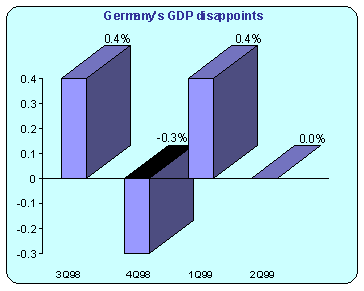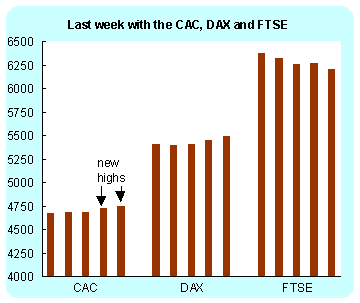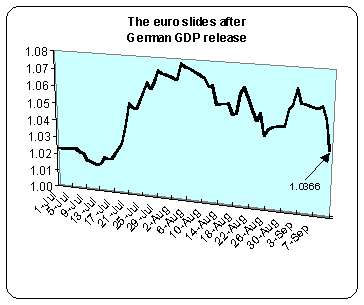
|
Today's Calendar |
| | Simply Economics |
| | International Perspective |
| | Resource Center |
 |
|
| 1999 Articles |
|
International Perspectives - September 13, 1999
A busy week...
Central Banks The Bank's Monetary Policy Committee (MPC) stunned the markets by opting for the quarter-point hike in its repo rate. The MPC cited world demand, the strength of consumption and the housing market, and a tight jobs market behind the move. Surprised analysts now see the BOE maintaining rates through the rest of this year. The bank last changed its base rate in June when it reduced the rate by a quarter point to 5 percent, which was a 22-year low. The so-called base rate - the rate at which it lends to other financial institutions - is the Bank's main tool to keep inflation near a government-set target of 2.5 percent.  The unusually low borrowing costs have resulted in a property boom in some parts of the country, and there is some evidence already of people converting their growing equity from house price inflation into disposable funds. Recent big increases in oil prices are also expected to feed through into inflation over the next two years. The gap between the value of imports and exports is growing to record levels, prompting expectations of a decline in sterling. Low interest rates keep the pound sterling cheap and would be welcomed by exporters - but would also make imported raw materials more expensive, putting upward pressure on inflation. Although conditions are looking relatively benign at present, the longer-term picture is more worrying to the Bank of England.
European Central Bank
APEC
Last weeks indicators Pan-German second quarter gross domestic product (seasonally adjusted) was at the low end of expectations, unchanged on the quarter and rising just 0.6 percent on the year. The main positive contributor was inventories. The August consumer price index was revised down to a level below expectations. The CPI fell 0.1 percent on the month and rose 0.7 percent on the year.  The July seasonally adjusted German trade surplus stood at 6.5 billion euros on a nominal basis, up slightly from June. German exports increased 1.4 percent on the month and 2.9 percent when compared with last year. Imports rose 1.4 percent both on the month and on the year. If the large surplus continues, net exports will make a stronger contribution to third quarter GDP than it did in the second quarter. The strong non-European Union export growth also suggests that Germany is benefiting from the recent weakness of the euro. The decline in the value of imports came as a surprise since import prices and raw materials prices rose strongly in recent months. France - Nominal wholesale sales rose one percent in June after a 3.2 percent increase in May. Second quarter sales were up 1.7 percent compared to the first quarter and were 4.1 percent above the previous year period. June sales increases were the result of divergent trends. Gains were led by a 2.8 percent recovery in capital goods and a one percent jump in consumer goods. By contrast, semi-finished goods sales were down 0.2 percent on the month but still up 3.8 percent on the quarter because the surge in oil prices boosted fuel sales. Gross Domestic Product rose faster than most analysts had expected. The increase was almost entirely due to stronger domestic demand, and in particular consumer spending. Second quarter GDP rose 0.6 percent after a 0.4 percent increase in the first quarter.  August's preliminary consumer price index continues to show there are only very weak inflationary pressures in Euroland's second largest economy and backs the European Central Bank's assessment that Euroland inflation is well under control. August's 0.1 percent rise was led by the ongoing increase in oil prices. In addition, the traditional jump in clothing prices after July's discounts boosted manufacturing prices. Real retail sales rose 2.1 percent in June, due to a surge in hypermarket sales. Food store sales recovered 7.5 percent on the month, led by a 15.1 percent surge in hypermarket sales. Non-food retail sales fell back 3.6 percent on the month, reflecting downward trends in both specialized and non-specialized stores. Vehicle sales and repairs were up 0.4 percent in June United Kingdom - July manufacturing production rose 0.3 percent but was still down 1.4 percent when compared with a year earlier. The figures were in line with market expectations and confirm that the sector is pulling out of recession. Total output was up 0.3 percent but was down 0.7 percent on the year. July industrial production was marginally stronger rising 0.3 percent on the month but declining 0.7 percent on the year. The CBI distributive trades' survey painted a fairly upbeat picture for UK retailers in August but data from the British Retail Consortium showed more subdued growth.
Asia Capital spending by Japanese corporations in the second quarter fell 13.4 percent when compared with the year earlier. But business sentiment at major Japanese companies in the July to September period improved slightly on the previous quarter. Australia - Wages rose modestly in the second quarter. Australian wages, excluding bonuses, rose 0.6 percent in the second quarter from the first quarter of 1999 and was up 3.2 percent from a year earlier, according to a wage cost index. The index measures movements in underlying wages by calculating the change in the wage and salary cost of a basket of jobs. Employment jumped in August. This should spur consumer spending and maintain Australia's robust economic growth. However, the unemployment rate also rose, suggesting excess capacity in the labor market. The number of housing finance approvals in Australia fell a seasonally adjusted 4.4 percent in July from June, starkly at odds with the 2.5 percent rise expected by analysts. The rate of growth in finance approvals has been slowing for five months.
Americas Employment was virtually unchanged in August and the unemployment rate crept up to 7.8 percent. Over the last year, full time employment gains (+2.9%) have outpaced part-time increases (+0.6%). Although overall employment growth has slowed considerably so far this year (+0.8%), hours worked have grown at a stronger pace (+1.5%). The large number of positive indicators released last week continue to fuel expectations of continuing growth with little inflation, giving investors little to be worried about.
World Equity Exchanges
Europe 
Asia
Currencies  The Japanese government and the Bank of Japan are deeply split over whether to intervene in currency markets to curb the rising yen. The government fears that the more expensive currency will hurt Japanese exporters who are the driving force pulling the country out of recession. But the Bank of Japan believes that currency intervention is pointless, and that government proposals would be inflationary. The markets believe that with Japan emerging from recession and the U.S. economy slowing down, the fundamentals are all on the side of the yen. But as the dollar weakens, some Japanese imports would be priced out of the U.S. market. That would help to contain the U.S. trade deficit.
Euro 
Why U.S. investors care...
The following indicators will be released this week.
Release dates are subject to change. |
||||||||||||||||||||||||||||||||||||||||||||||||||||||||||||||||||||||||||||||||||||||||||||||||||||||||||||||||||||||||||||||||||||||||||||||||||||||